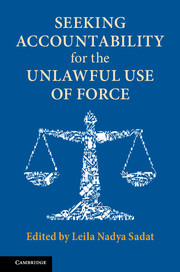Book contents
- Frontmatter
- Dedication
- Contents
- Notes on Contributors
- Foreword
- Preface
- Table of Cases
- Introduction
- PART I HISTORIC AND CONTEMPORARY PERSPECTIVES ON THE UNLAWFUL USE OF FORCE
- 1 The Status of Aggression in International Law from Versailles to Kampala – and What the Future Might Hold
- 2 Nuremberg and Aggressive War
- 3 The Tokyo International Military Tribunal and Crimes Against Peace (Aggression): Is There Anything to Learn?
- 4 The Just War in Ancient Legal Thought
- 5 Definitions of Aggression as Harbingers of International Change
- 6 International Humanitarian Law in an Age of Extremes: Unlawful Uses of Force by Non-State Actors
- PART II MECHANISMS FOR RESTRAINING THE UNLAWFUL USE OF FORCE AND ENHANCING ACCOUNTABILITY
- PART III THE ILLEGAL USE OF FORCE AND THE PROSECUTION OF INTERNATIONAL CRIMES
- PART IV IMAGINING A BETTER WORLD
- Epilogue
- Index
5 - Definitions of Aggression as Harbingers of International Change
from PART I - HISTORIC AND CONTEMPORARY PERSPECTIVES ON THE UNLAWFUL USE OF FORCE
Published online by Cambridge University Press: 21 May 2018
- Frontmatter
- Dedication
- Contents
- Notes on Contributors
- Foreword
- Preface
- Table of Cases
- Introduction
- PART I HISTORIC AND CONTEMPORARY PERSPECTIVES ON THE UNLAWFUL USE OF FORCE
- 1 The Status of Aggression in International Law from Versailles to Kampala – and What the Future Might Hold
- 2 Nuremberg and Aggressive War
- 3 The Tokyo International Military Tribunal and Crimes Against Peace (Aggression): Is There Anything to Learn?
- 4 The Just War in Ancient Legal Thought
- 5 Definitions of Aggression as Harbingers of International Change
- 6 International Humanitarian Law in an Age of Extremes: Unlawful Uses of Force by Non-State Actors
- PART II MECHANISMS FOR RESTRAINING THE UNLAWFUL USE OF FORCE AND ENHANCING ACCOUNTABILITY
- PART III THE ILLEGAL USE OF FORCE AND THE PROSECUTION OF INTERNATIONAL CRIMES
- PART IV IMAGINING A BETTER WORLD
- Epilogue
- Index
Summary
INTRODUCTION
Debates about the definitions of aggression are responses to deadlock and harbingers of change. Each, in its own way and in its own time, has heralded a transition from an old to a new set of legal and institutional arrangements. The definitions in the early 1930s, which emerged in response to the failings of the League of Nations, signaled the shift away from the old dichotomy of belligerency and neutrality, and toward a new regime based on legitimate and illegitimate wars. The definitions of the early 1950s, responding to the Cold War Security Council deadlock, presaged the United Nations’ transition from collective security organization to conflict mediator. The General Assembly's definition of 1974, negotiated during the era of détente, might, had the “new” Cold War not intervened, have heralded new alignments between powerful States. And the definition in the 2010 Kampala Amendments, anticipating shifts from a unipolar to a multipolar world, proposes dual sources of authority – the Security Council and International Criminal Court – on the handling of aggression.
Although debates about definitions herald change, they have also given rise to remarkably durable patterns of state behavior, patterns still being repeated to this day. The most consistent advocates of automatic yardsticks of aggression have been States vulnerable to attack or excluded from either the League Council or Security Council. These “excluded” States have not only looked to definitions for legal protection against the vicissitudes of international life, but have also tried to use them to break the powerful States’ monopoly over the determination of aggression. This pattern was first discernible during the interwar years. In 1933, for example, the Soviet Union (a vulnerable State), backed by France (another vulnerable State), broached a definition at the Conference for the Reduction and Limitation of Armaments (Disarmament Conference). During the Cold War decades, smaller States, beguiled by the prospect of undermining the Security Council's mandate under Article 39, kept the definitional flame alight. And today a legion of small, middling, and quite large “excluded” States posit International Criminal Court jurisdiction over the crime of aggression as an alternative (or, more diplomatically, a supplement) to Security Council determination.
- Type
- Chapter
- Information
- Seeking Accountability for the Unlawful Use of Force , pp. 122 - 153Publisher: Cambridge University PressPrint publication year: 2018
- 2
- Cited by

